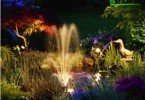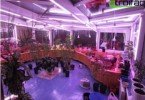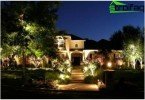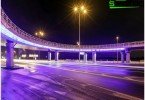Examples of architectural lighting
Architectural lighting is a decorative illumination of the facade of a building or any other structure: a pool, a pond, a bridge, a gazebo. It solves several problems at the same time – it highlights the architectural object, decorates it, creates a festive mood. Also, using this technique, you can create a “presence effect” in the house of people, which will help scare away night thieves.
Content
- Architectural Lighting Ideas
- Options for architectural lighting of facades
- Equipment for architectural lighting
- Installation methods for spotlights and fixtures
Architectural Lighting Ideas
The very idea of highlighting facades arose long ago, after the First World War. The pioneers in this matter were the Americans, who illuminated the skyscrapers in Manhattan so well that the American press immediately dubbed the area “City of Illuminated Castles in the Air”. Now this method of lighting design has also been applied in private housebuilding, and you can beautifully illuminate a house of any size – a three-story mansion with columns, and a twenty-meter summer house on six hundred square meters.
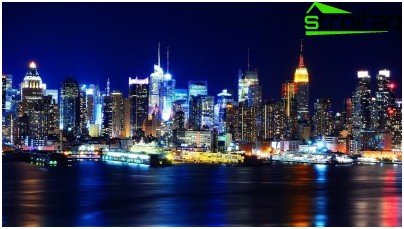
Manhattan Skyscrapers Illuminated Outside by Colorful Rays
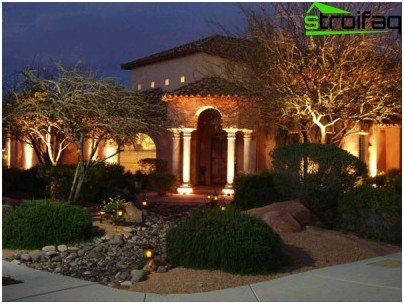
Manor type architectural lighting
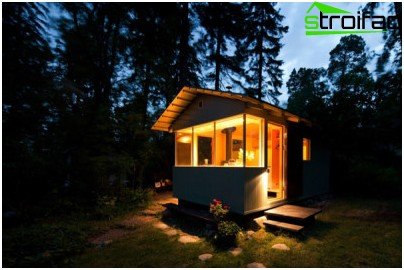
Outdoor lighting of a Finnish-style small house
Options for architectural lighting of facades
In private households, one of three methods of illuminating facades can be successfully applied:
- Continuous filling of the facade with light. This option is suitable for large buildings made of beautiful relief material, for example, natural stone or its imitation. Such lighting highlights the entire building. It is carried out using spotlights mounted on the ground or on special supports. It is clear that this lighting is designed so that the light of the spotlights does not directly enter the windows..
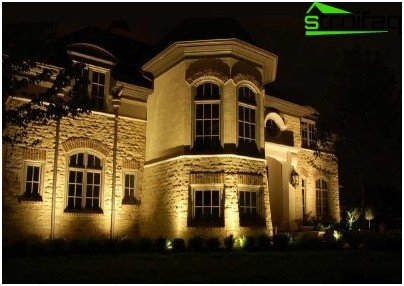
Light completely fills the facade trimmed with relief stucco
Accent lighting is a more delicate and economical way to highlight and illuminate an object. Lamps are mounted directly on the facade and illuminate only its most beautiful elements – cornices, window openings, balustrades, balconies, columns, stucco moldings. The combination of dark and lighted areas favorably emphasizes the architectural merits of the building. This is the most popular option..
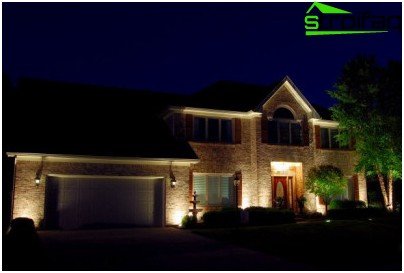
Accent lighting of the cottage, made using ground projectors and facade lamps
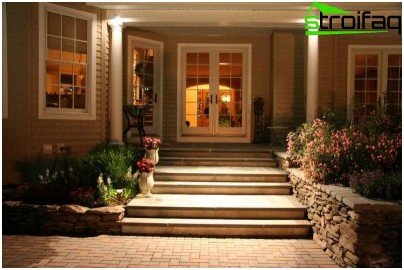
Accent architectural lighting of the entrance to the house
Contour lighting is a novelty of lighting design, made possible by the advent of a new type of fixtures: LED rulers or flexible neon, which is a luminous cord made of PVC with LEDs soldered inside. It is sold for meters, easily bends and cuts. This architectural LED lighting is mounted on the facade using rails. Contour lighting is convenient in that it can be applied situationally, for example, to decorate a building only for a holiday.
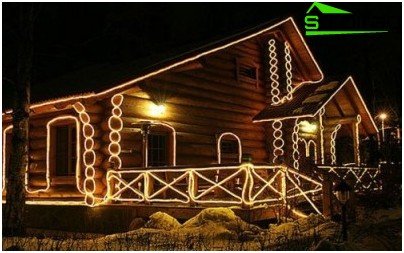
Original contour lighting of a small cottage
Equipment for architectural lighting
Since the maintenance of facade lamps is often difficult due to the height at which they are mounted, all equipment must be reliable, convenient to maintain and protected from the harmful effects of street conditions. All lighting elements: brackets, fixtures, spotlights must be resistant to temperature extremes, humidity and dust. In addition, they should give out narrow beams of light. Therefore, fixtures of special designs are being developed for architectural lighting, and wide-profile fixtures are not suitable here.
Such characteristics as energy saving and durability of lighting devices cannot be neglected. The best in terms of these indicators are halogen and fluorescent lamps. However, LEDs are most often used now, because they do not need to be serviced at all and they consume very little electricity. Manufacturers claim that such lamps serve 100,000 hours (for comparison, an incandescent lamp – 1000, a fluorescent lamp – 10,000). But in fact, after about 25,000 hours of operation, the LED will fade and it will be better to replace it. And yet, architectural outdoor lighting massively switches to LEDs; this is greatly facilitated by the fact that over the past few years these lamps have fallen in price by about half.
Installation methods for spotlights and fixtures
To determine where and how to mount or install a lighting fixture, you first need to decide what exactly you will light. Three types of surfaces can be distinguished here:
- vertical – wall, dome, column;
- horizontal lower – floor, stairs;
- horizontal top – top of the arch, niches, canopy.
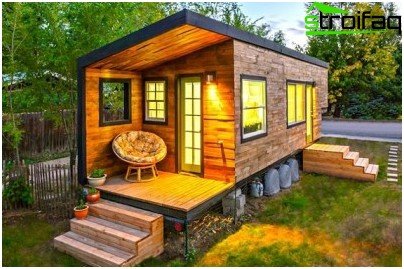
External illumination of a country house – trailer
After that, you need to decide where it will be more convenient to place the light source. Lamp or spotlight can be installed:
- on the surface itself: integrate into it or fasten to the console (ceiling lamps are usually not taken out to the console);
- on the ground, the beam is angled upward;
- on an adjacent building or pillar, while the beam can be directed up, down, horizontally;
- suspend on a cable and direct a beam of light down.
And the last stage is the determination of the nature of light – its intensity, color, size of the light spot, whether dynamic special effects are needed: changing the color of the beam, its brightness, ripple.
As you probably already understood, it is not always easy to come up with, design and install architectural lighting on your own, because it requires some special knowledge of electrics and design at the same time. Therefore, if you feel that you can’t do it yourself, you can simply ask for help from a company specializing in this type of activity. Fortunately, they are now in every large settlement, because architectural outdoor lighting is now in demand, like never before.



